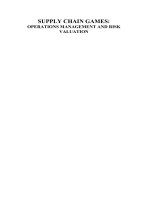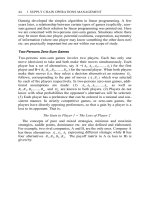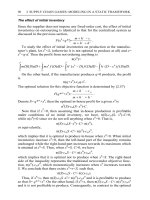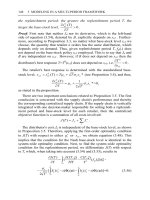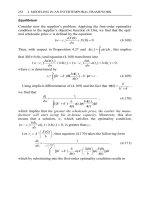Operations management heizer 6e ch12
Bạn đang xem bản rút gọn của tài liệu. Xem và tải ngay bản đầy đủ của tài liệu tại đây (493.47 KB, 77 trang )
Operations
Management
Chapter 12 –
Inventory Management
PowerPoint presentation to accompany
Heizer/Render
Principles of Operations Management, 6e
Operations Management, 8e
© 2006
Prentice
Hall, Inc. Hall, Inc.
©
2006
Prentice
12 – 1
Outline
Global Company Profile:
Amazon.Com
Functions Of Inventory
Types of Inventory
Inventory Management
ABC Analysis
Record Accuracy
Cycle Counting
Control of Service Inventories
© 2006 Prentice Hall, Inc.
12 – 2
Outline – Continued
Inventory Models
Independent versus Dependent
Demand
Holding, Ordering, and Setup Costs
© 2006 Prentice Hall, Inc.
12 – 3
Outline – Continued
Inventory Models For Independent
Demand
Basic Economic Order Quantity
(EOQ) Model
Minimizing Costs
Reorder Points
Production Order Quantity Model
Quantity Discount Models
© 2006 Prentice Hall, Inc.
12 – 4
Outline – Continued
Probabilistic Models and Safety
Stock
Other Probabilistic Models
Fixed-Period (P) Systems
© 2006 Prentice Hall, Inc.
12 – 5
Learning Objectives
When you complete this chapter, you
should be able to:
Identify or Define:
ABC analysis
Record accuracy
Cycle counting
Independent and dependent
demand
Holding, ordering, and setup
costs
© 2006 Prentice Hall, Inc.
12 – 6
Learning Objectives
When you complete this chapter, you
should be able to:
Describe or Explain:
The functions of inventory and
basic inventory models
© 2006 Prentice Hall, Inc.
12 – 7
Amazon.com
Amazon.com started as a “virtual”
retailer – no inventory, no
warehouses, no overhead; just
computers taking orders to be filled
by others
Growth has forced Amazon.com to
become a world leader in
warehousing and inventory
management
© 2006 Prentice Hall, Inc.
12 – 8
Amazon.com
1. Each order is assigned by computer to
the closest distribution center that has
the product(s)
2. A “flow meister” at each distribution
center assigns work crews
3. Lights indicate products that are to be
picked and the light is reset
4. Items are placed in crates on a conveyor.
Bar code scanners scan each item 15
times to virtually eliminate errors.
© 2006 Prentice Hall, Inc.
12 – 9
Amazon.com
5. Crates arrive at central point where items
are boxed and labeled with new bar code
6. Gift wrapping is done by hand at 30
packages per hour
7. Completed boxes are packed, taped,
weighed and labeled before leaving
warehouse in a truck
8. Order arrives at customer within a week
© 2006 Prentice Hall, Inc.
12 – 10
Inventory
One of the most expensive assets
of many companies representing as
much as 50% of total invested
capital
Operations managers must balance
inventory investment and customer
service
© 2006 Prentice Hall, Inc.
12 – 11
Functions of Inventory
1. To decouple or separate various
parts of the production process
2. To decouple the firm from
fluctuations in demand and
provide a stock of goods that will
provide a selection for customers
3. To take advantage of quantity
discounts
4. To hedge against inflation
© 2006 Prentice Hall, Inc.
12 – 12
Types of Inventory
Raw material
Purchased but not processed
Work-in-process
Undergone some change but not completed
A function of cycle time for a product
Maintenance/repair/operating (MRO)
Necessary to keep machinery and processes
productive
Finished goods
Completed product awaiting shipment
© 2006 Prentice Hall, Inc.
12 – 13
The Material Flow Cycle
Cycle time
95%
Input
Wait for
inspection
Wait to
be moved
5%
Move Wait in queue Setup Run
time for operator time time
Output
Figure 12.1
© 2006 Prentice Hall, Inc.
12 – 14
Inventory Management
How inventory items can be
classified
How accurate inventory records
can be maintained
© 2006 Prentice Hall, Inc.
12 – 15
ABC Analysis
Divides inventory into three classes
based on annual dollar volume
Class A - high annual dollar volume
Class B - medium annual dollar
volume
Class C - low annual dollar volume
Used to establish policies that focus
on the few critical parts and not the
many trivial ones
© 2006 Prentice Hall, Inc.
12 – 16
ABC Analysis
Item
Stock
Number
#10286
Percent of
Number of
Items
Stocked
x
Unit
Cost
=
Annual
Dollar
Volume
Class
1,000
$ 90.00
$ 90,000
38.8%
#11526
500
154.00
77,000
33.2%
A
#12760
1,550
17.00
26,350
11.3%
B
350
42.86
15,001
6.4%
1,000
12.50
12,500
5.4%
#10867
#10500
© 2006 Prentice Hall, Inc.
20%
Annual
Volume
(units)
Percent of
Annual
Dollar
Volume
30%
72%
23%
A
B
B
12 – 17
ABC Analysis
Item
Stock
Number
Percent of
Number of
Items
Stocked
Annual
Volume
(units)
x
Unit
Cost
=
Annual
Dollar
Volume
Percent of
Annual
Dollar
Volume
Class
#12572
600
$ 14.17
$ 8,502
3.7%
C
#14075
2,000
.60
1,200
.5%
C
100
8.50
850
.4%
#01307
1,200
.42
504
.2%
C
#10572
250
.60
150
.1%
C
#01036
© 2006 Prentice Hall, Inc.
50%
5%
C
12 – 18
Percent of annual dollar usage
ABC Analysis
80
70
60
50
40
30
20
10
0
A Items
–
–
–
–
–
–
–
B Items
–
|
|
|
|
–
10 20 30 40
C Items
|
|
|
|
50
60
70
80
Percent of inventory items
© 2006 Prentice Hall, Inc.
|
|
90 100
Figure 12.2
12 – 19
ABC Analysis
Other criteria than annual dollar
volume may be used
Anticipated engineering changes
Delivery problems
Quality problems
High unit cost
© 2006 Prentice Hall, Inc.
12 – 20
ABC Analysis
Policies employed may include
More emphasis on supplier
development for A items
Tighter physical inventory control for
A items
More care in forecasting A items
© 2006 Prentice Hall, Inc.
12 – 21
Record Accuracy
Accurate records are a critical
ingredient in production and inventory
systems
Allows organization to focus on what
is needed
Necessary to make precise decisions
about ordering, scheduling, and
shipping
Incoming and outgoing record
keeping must be accurate
Stockrooms should be secure
© 2006 Prentice Hall, Inc.
12 – 22
Cycle Counting
Items are counted and records updated
on a periodic basis
Often used with ABC analysis to
determine cycle
Has several advantages
Eliminates shutdowns and interruptions
Eliminates annual inventory adjustment
Trained personnel audit inventory accuracy
Allows causes of errors to be identified and
corrected
Maintains accurate inventory records
© 2006 Prentice Hall, Inc.
12 – 23
Cycle Counting Example
5,000 items in inventory, 500 A items, 1,750 B items, 2,750 C
items
Policy is to count A items every month (20 working days), B
items every quarter (60 days), and C items every six months
(120 days)
Item
Class
Quantity
A
500
Each month
B
1,750
Each quarter
C
2,750
Every 6 months
Cycle Counting Policy
Number of Items
Counted per Day
500/20 = 25/day
1,750/60 = 29/day
2,750/120 = 23/day
77/day
© 2006 Prentice Hall, Inc.
12 – 24
Control of Service
Inventories
Can be a critical component of
profitability
Losses may come from shrinkage or
pilferage
Applicable techniques include
1. Good personnel selection, training, and
discipline
2. Tight control on incoming shipments
3. Effective control on all goods leaving
facility
© 2006 Prentice Hall, Inc.
12 – 25




